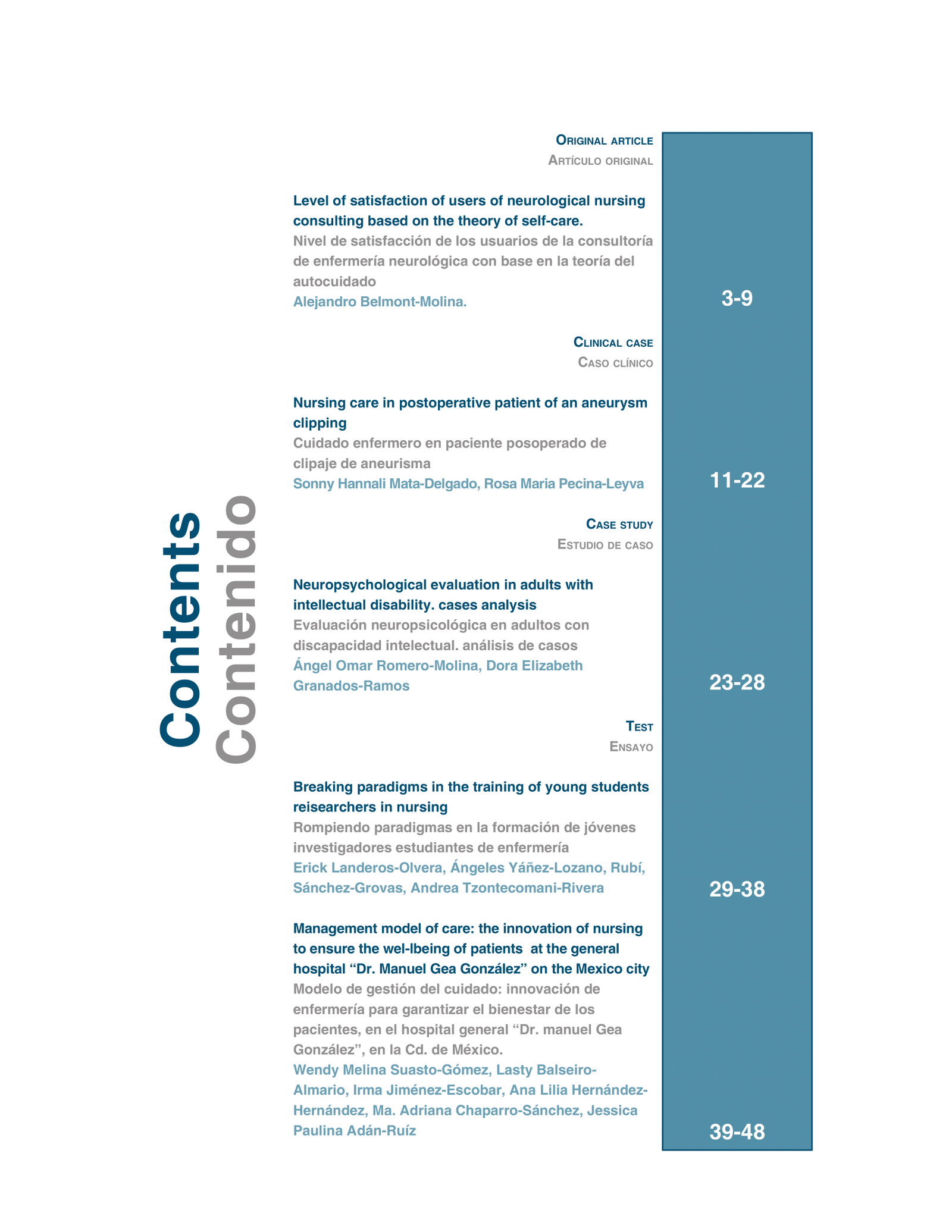Cuidado enfermero en paciente posoperado de clipaje de aneurisma
DOI:
https://doi.org/10.51422/ren.v17i3.267Palabras clave:
aneurisma cerebral, EVC hemorrágico, proceso cuidado enfermero (PCE), posoperatorioResumen
Introducción: los aneurismas cerebrales son dilataciones localizadas de la pared arterial, por lo general, se encuentran en puntos de bifurcación como las arterias grandes del polígono de Willis, las cuales tienen potencial de ruptura y traen consigo complicaciones serias, tales como el evento vascular cerebral (EVC) hemorrágico, en donde la mortalidad es del 66%. Debido al impacto que tiene dicha enfermedad, el profesional de enfermería requiere brindar cuidado integral a este grupo de pacientes, a través del uso del Proceso Cuidado Enfermero (PCE), el cual está dirigido hacia la planificación y el desarrollo de cuidados sistematizados, lógicos y racionales.
Objetivo: desarrollar un plan de cuidado de enfermería mediante el uso de la taxonomía NANDA NIC NOC para un paciente posoperado de clipaje de aneurisma en base a la fisiopatología de la enfermedad y su intervención quirúrgica a partir de un caso clínico.
Material y métodos: valoración por patrones funcionales de salud de un paciente posoperado de clipaje de aneurisma, revisión bibliográfica y elaboración del proceso cuidado enfermero (PCE) individualizado con el uso de la taxonomía NNN.
Conclusión: el paciente neuroquirúrgico, representa un gran reto en el área de salud, por lo que, el profesional de enfermería debe responder a las necesidades sociales y propias de la disciplina para desempeñar un papel eficiente en la ejecución de un plan de cuidado individualizado, que permita el logro de resultados establecidos por el equipo multidisciplinario.
Descargas
Citas
Acevedo Arguello JC, Baracaldo-Campo HA, Padilla García CI. Propuesta de plan de cuidado a la persona con aneurisma cerebral. Medunab [en línea]. 2012 Abr [consulta: 24 sep 2017]; 15(1): 46-52. Disponible en: https://revistas.unab.edu.co/index.php/medunab/article/view/1567
Black P, Rossitch Jr E. Neurosurgery an introductory text. New york: Oxford university press; c2002.
Andrade Cepeda RM. Proceso de Atención de Enfermería. México: Trillas; 2012.
T. HH. NANDA Internacional. Diagnósticos enfermeros. Definiciones y clasificaciones 2015- 2017. Amsterdam, 2015.
Moorhead S, Johnson M, Maas M, Swanson E. Clasificación de resultados de enfermería (NOC). 4a ed. España: Elsevier;2009.
Bulechek GM, Butcher HK, Dochterman JM, Wagner CM. Casificación de intervenciones de enfermería (NIC) 6ª ed. España: Elsevier; 2014.
Romano F.. Nieto A., Corti M., Salas D., Zumztein D., Douglas A., et al. Experiencia quirúrgica en aneurismas cerebrales intervenidos en el IAHULA, Mérida Venezuela entre Enero de 2008 a Diciembre de 2015. Avances en biomedicina [en línea]. 2017 [consulta 11 sep 2017]; 6(1):37-47. Disponible en: http://www.redalyc.org/articulo.oa?id=331351068006
Benavent G., Ferrer F., Francisco del Rey C. Fundamentos de enfermería: juicio y acción terapéutica: planificación, ejecución y evaluación. Madrid: Lexus; 2012.
Smeltzer S., Bare B., Hinkle J., Cheever K., Brunner y Suddarth Enfermería médico-quirúrgica. 12a ed. Philadelphia: Lippincott; 2013.
Bekelis K, Missios S, Coy S, Rahmani R, Singer RJ, Mackenzie TA. Surgical clipping versus endovascular intervention for the treatment of subarachnoid hemorraghe patients in New york state. Revista Mexicana de Neurociencia [en línea].2015 sep [citado 21 sep 2017]; 17(1): 2-9. Disponible en: https://bit.ly/2ps7hz8
García Vázquez AM, Antón Aguilar L, Montero Pérez FJ, Solivera Vera J, Lozano Sánchez J, Jiménez Murillo L. Hemorragia subaracnoidea espontánea. En: Jiménez Murillo L, Montero Pérez FJ. Medicina de urgencias y emergencias. 5ta ed. España: Elsevier; 2015. pp 397-402.






